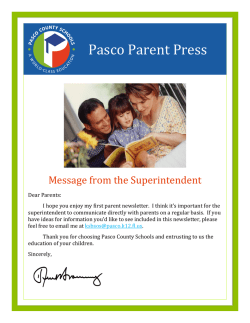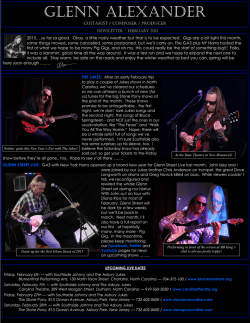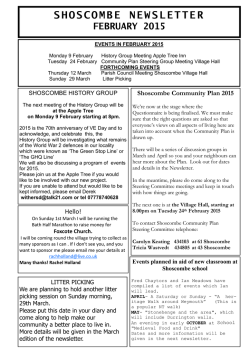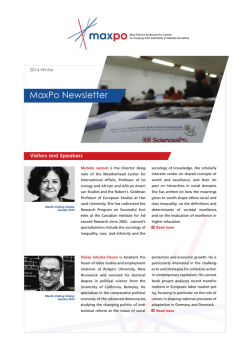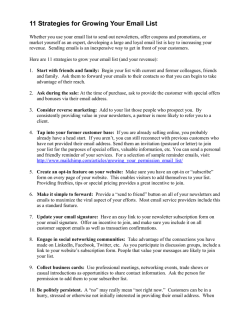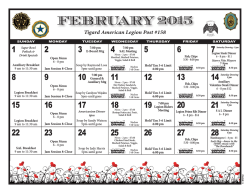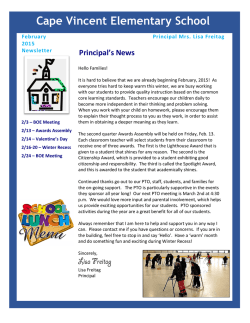
Winter 2015 NM ASMP Newsletter
asmpnm newsletter in this issue president ’s message board activity asmp update karen novotny Turning a C into an A+. Gregory Heisler Interview Gabriella Marks a post-thanksgiving adventure Karen Novotny Member List Final Frame David Halpern 4 6 7 8 20 30 33 34 ON THE COVER: © Irene Qwsley 2014 ASMP New Mexico Newsletter Editor Steve Zeifman 505-982-8293 [email protected] Associate Editor David Halpern (505) 983-0877 [email protected] Associate Editor Ford Robbins (505) 660-4064 [email protected] Layout Ford Robbins ASMP-NM Board Members President Gabriella Marks Vice President David Halpern Vice President Peter Ogilvie Secretary Richard Khanlian Treasurer Karen Novotny Tischer Board Members Tony Bonanno Robert C Reck Ford M Robbins Steven Alan St. John Jamie Stillings Sally Thomson Contact Information Gabriella Marks [email protected] David Halpern [email protected] This newsletter is a volunteer effort by Steve Zeifman, David Halpern and Ford Robbins. If you by chance find any errors in spelling, grammar or any other oversights please let us know. The ASMP-NM newsletter is a periodic newsletter. If you have received this newsletter and would like to be added to the mailing list please contact us. SUBMISSIONS are not dependant on any publication date and are welcome anytime. Please contact David Halpern at [email protected] for a copy of our submission Guidelines. All images copyright © the respective photographer or as attributed. asmp-nm.org Page 3 Winter 2015 asmpnm newsletter president’s message Gabriella Marks © Bill Stengel In 2015, we’re ringing in the new year at ASMP an interest in becoming more active in your local chap- with a new Executive Director, Tom Kennedy. There’s a ter, the new year is a great time to set that new habit. We tremendous amount of enthusiasm for the new director, would love to have some new faces and voices join the who began his career as a newspaper photo journalist— board - please contact me at gabriella@triggerfinger. first in Florida, then at the Philadelphia Inquirer where com to attend our next board meeting. he transitioned to being a photo editor. Many are most familiar with his work as the Director of Photography at - including student outreach, scholarship opportunities, National Geographic and managing editor, multimedia at and educational workshops - but we need your help to the Washingtonpost.Newsweek Interactive (WPNI). make it happen. I’ve always been a firm believer that you get as much from a project - or an organization - as you Kennedy will be holding a series of webinars We have a number of other goals set for this year at the end of January, as a kind of virtual online tour to are willing to put in - consider actively participating in both introduce himself to members and to get member’s your New Mexico ASMP community today. perspectives on the industry, and how ASMP can best support its membership. There are a number of dates tor Tom Kennedy described what he felt was his most and times to accommodate busy schedules - I encour- important role as a photo editor working with photogra- age you to reserve the time to “meet” Kennedy if your phers: “One of my goals was to fully understand where schedule permits by going to: http://www.asmp-nm.org/ the photographers’ hearts and passions lay and to un- content/meet-tom-kennedy. If you don’t have the time derstand how they intended to define career success for for the webinar, you can also read a great interview here: themselves.” http://asmp.org/kennedy to asses the successes (and failures) of the past year, and Here in New Mexico, we’re starting the new year In his interview, ASMP’s new executive direc- The beginning of a new year is a traditional time with a talk on January 28 at Tipton Hall called “21st Cen- re-calibrate goals and strategies for the one to come. tury Hustle” by photographer/writer/educator and Taos Kennedy’s statement really struck home personally—for resident Jonathan Blaustein. We’re also planning a panel me, the act of articulating that passion, focusing in on conversation on photographing in Cuba, and a presenta- what I want to do and defining criteria for success is an tion on “Motion Workflow” with Bill Stengel and Michael ongoing conversation, and one made all the richer within Clark in the upcoming months. the context of a creative community. I’m looking forward to having that conversation with ASMP members over the We can always use a helping hand with ideas, event planning and chapter mission. If you have ever had a s m p mission statement ASMP is dedicated to promoting the highest professional standards of media photography. We offer programs, seminars, timely news and business support for the professional media photographer. We also offer an online searchable database for photo buyers to contact our members, some of the best working professionals in the industry. ASMP was founded in 1944 by a handful of the world’s leading photojournalists and is recognized internationally for its leadership role. ASMP has over 5,000 members, including many of the world’s greatest photographers, in 40 chapters nationwide. ASMP is the leading trade association for photographers who photograph primarily for publication. The ASMP has three purposes: To protect and promote the interests of photographers whose work is for publication, to promote high professional standards and ethics and to cultivate friendship and mutual understanding among photographers. coming year. Page 5 Winter 2015 board activity The Chapter Board meet on November 12, 2014 to take the following actions and discuss the fllowing matters. Karen Novotny, our Treasurer, reported that the Chapter had a checking account balance of $1,318.85 as of 9/7/14. There were no outstanding payables. Cash on hand was $82.45, resulting in total funds available of $1,401.30. The Chapter had receivables due from National of $445.38 and a 2014 allotment balance of $518.36, resulting in total 2014 operating funds available for the last quarter of the year of $2,365.04 The Samy’s Camera event schedule to follow the Board meeting generated much discussion. Samy’s will send items for testing and trial to the Peter Ogilvie on request. Peter suggested the Board make a list of what equipment it would like to test, he make the request, and we all try it out. The Board agreed to a tentative schedule of sponsored events for 2015: (a) Target four Meet and Greet. events. (b) A lecture/presentation by Jonathan Blaustein. SFUAD enthusiastic to support and will provide Tipton Hall for this and other events. For the Blaustein event, SFAUD will split the $300 cost. (c) A Cuba Panel in February, to be held in Albuquerque, unless SF Workshops wants to co-sponsor, then at Workshops. 5-6 images for each panelist with a short presentation. (d) In March, Bill Stengel will present on motion and motion workflow. [Look up Bill’s video re Red Bull on his website.] (d) Brad Wilson in April. His retouching is intense. He has built a commercial career out of his personal work with lions. (e) In May, David Halpern on Bandalier. Tony O’Brien, Dean of the Photograpghy Department, SFUAD, wants to do more salons. In June SFUAD students do a 4-6 images each show. That would be a good time for ASMP involvement, sincluding mentoring, reviews, internships also. Two board members had a short side-bar discussion about business licenses required by the City & County, referring to Santa Fe. The Board asked for a short article in the newsletter on the subject. [It will appear in a future issue] A board member asked if we gave talks to students on business practices. Peter Ogilvie had just talked with SFCC students on the topic that afternoon. There was general consensus that we could do more in this area. Discussion continued on the possibilty of a combined commercil/fine art presentation. It was suggested that perhaps Getty is a good valuation source for bidding/invoicing a photo. There are several data bases also available. ASMP has been hosting Webinars as well. The meeting adjourned to enjoy the Samy’s Camera event. asmp update asmpnm newsletter ASMP Board Selects Next Executive Director The Board of Directors of ASMP has announced the selection of Thomas R. Kennedy as the Society’s Executive Director, effective January 1, 2015. Kennedy is an internationally known visual communicator with extensive experience in print and online journalism. According to ASMP National Board Chair Gail Mooney, “We are delighted to welcome Tom as the new Executive Director of ASMP and look forward to his vision and guidance.” Kennedy said, “ASMP needs to help its members navigate through the turbulence induced by changes to the media landscape. That turbulence, which has affected how our ASMP members can make their living, requires building of community, wise positioning and agility in the face of the changes being unleashed. Notwithstanding these challenges, I see this as a tremendous time for professional photographers to be in the vanguard for visual storytelling.” Kennedy has led teams of visual journalists, managed large departmental budgets and directed and edited journalism projects that have earned Pulitzer Prizes, Emmy Awards, the George Foster Peabody Award, and multiple Edward R. Murrow Awards for web-based journalism. Kennedy has also taught for a number of academic programs as an adjunct professor and, most recently, he has been a multimedia consultant, advising individual photographers and organizations on the use of visual communication. Read more about Tom here. New Leadership Discussion Platform: Hey Chapter Leaders! We’ve listened to you and your desire to have a better platform for discussions than the old list serve, and we’re excited to let you know that we’re moving the Leadership Discussions to a private Facebook Group! We hope that you will find this platform easier to stay connected to discussions and each other, and can help facilitate the continued growth of communication between you! https://www.facebook.com/groups/ASMPleadership/ We will be shuttering the old list serve by the end of the year, so please migrate over to the Facebook group as soon as possible! Page 7 Winter 2015 asmpnm newsletter K A R E N N O V O T N Y Page 9 Winter 2015 Karen Novotny asmpnm newsletter Turning a “C” into an “A+” It’s all about loving what you do. An interview with Karen Novotny Tischer By David Halpern, Associate Editor Karen Novotny’s father was the chairman of The School of Art at Kent State University, so she grew up surrounded by artists. “I took some art classes, but my dad gave me a C,” she said with a laugh. “One of my favorite artists on his staff was married to an interior designer and the two of them claimed photography was not an art, so I never pursued it as an art outlet. I took silversmithing and I loved that, but it took a long time to make a piece, and when I lived in San Francisco, someone broke into my house and took every piece of jewelry I’d ever made.” But I’m getting ahead of Karen’s story, which began in Kent, Ohio when her father let her use his Leica to make pictures, some of which he used as reference material for his paintings. KNT: “When I graduated from high school, he gave me a nice camera and sent me on a trip to Europe. I have boxes of slides from that trip that I’d like to look at to see if what’s there. I know there must be some material because my dad borrowed some.” Above: Bisti Vista Preceding Page: LaFonte Plaza Metro, Washington DC “Wherever I traveled, I took a camera and really just photographed subjects that my father would paint. That’s what my eye was drawn to. I’d sit on the steps that went down to his studio and watch him paint. His back was always toward me, so he didn’t know I was there. His sense of color and composition undoubtedly influenced the way I look at things, but I wasn’t really conscious of that.” DH: “Was your mother an artist, too?” KNT: “My mother did some jewelry work and I still have some of her pieces, but no, she was more a writer, a humorist, and a pianist.” DH: “Was she also on the Kent State faculty?” KNT: “No, those were the days when a woman wasn’t supposed to work outside the home, so my father had many jobs. He taught classes, managed the department and he’d drive to Cleveland to teach classes at the Cleveland Institute of Art a night.” DH: “So what was your major in college?” KNT: “Chemistry and Education—with a math minor. I couldn’t go into the arts; my father was already an artist and, for me, that was too much competition. Plus, he was always giving me a C.” DH: “So how in the world did you decide that you wanted to become a photographer?” KNT: “I don’t think I really decided that I wanted to become a photographer. I was always photographing, but not doing anything with my pictures. Except when I was in high school, I never did anything in the darkroom. Not all that long ago, I bought a digital camera, and I looked back at all the photographs I had taken and saw that they were mostly of buildings. So I did an architectural job for an architect friend in San Francisco. DH: The many diverse paths people take to become a photographer always fascinate me. After graduating from Kent State, Karen taught seventh and eighth grade math in Washington, DC. She returned to Ohio where she did the same in Cuyahoga County. Walt Disney Concert Hall, Los Angeles KNT: “Then I returned to Washington and taught math once again. But, I got tired of that. I wasn’t Page 11 Winter 2015 Karen Novotny asmpnm newsletter actually tired of it, but I didn’t like the teachers, because they hated the kids. And, I didn’t like the school board because they wanted me to teach the book and not the child. So I left, not knowing what to do. I volunteered on a pre-convention presidential campaign in DC for a summer and while there a friend made a suggestion that I go to work for IBM.” “Well…I came from an education background and didn’t know anything about the business. I had to go find out what IBM was and what I might do for them. I decided that I should be a systems engineer and went on interviews with several computer companies who said ‛Oh, you don’t want to be a systems engineer; you want to do data entry.’ I said, No…I don’t think so (That really didn’t require much thought). IBM was the only company that said ‛You’d probably make a good systems engineer.’ But they also said that the hours would be long and they didn’t pay much. I told them I wasn’t afraid of work. So I went to work for IBM and I was there for twenty years, working in Washington DC, Boston and San Francisco.” DH: “And then you went into photography?” KNT: “No. I left IBM when a good buy out option was offered and started my own software education and consulting company. It still provides me with almost enough income to support my photography habit. Pink Slippers After 9/11, I left the San Francisco Bay area and moved to Santa Fe where I found the Santa Fe Workshops. I took lots of classes there, met other photographers, joined ASMP with the encouragement of Peter Ogilvie, entered some contests, and won some awards. I focus on architectural photography because I like buildings and interi- ors – they reflect the society and the residents. I try to focus on green-built homes and, for fine art, the disintegrating interiors like those I found in Cuba.” DH: “Who have been your influences?” KNT: I’ve admired Jay Maisel’s work. His photographs remind me of my father’s paintings. I also like his approach to teaching because it tends to be heavy on critiques, which I find helpful, and on self criticism which makes one think about what draws them to a subject or to a particular way of looking at subjects.” “Kip Brundage has been an influence with his terrific critiques. I studied with Jay and Kip through the Santa Fe Workshops.” DH: In addition to your architectural photography, your personal work also demonstrates an interest in the natural environment. One of your photographs from the Black Place appeared on the cover of our last newsletter, and I know you’ve photographed in Yellowstone and various New Mexico badlands, too. KNT: Yes, and I’ve submitted four of my landscape images to accompany this interview. DH: “You serve as treasurer on the ASMP-NM board. What are your feelings about the value of ASMP membership?” KNT: “Contact with other photographers is the greatest benefit to me because I’m so new to the world of photography. Peter Ogilvie said to me, when we first met and he refused my offer to pay for his advice, ‛We’re here to help others…’ and that’s what I do, too. The Only Radio Page 13 Winter 2015 Karen Novotny asmpnm newsletter Privy with a View Too Late to Leave Page 15 Winter 2015 Karen Novotny asmpnm newsletter Upper Left: Bedroom for Four Upper Right: DeYoung Museum Garden Lower Left: Orange Geyser Lower Right: Stone Flower Karen can be contacted at [email protected]. Page 17 Winter 2015 asmpnm newsletter Photographs from Irene Owsley’s Alaska Wilderness Panoramas Series Spotlighted in Two Current Museum Exhibitions Waterscape Panorama Featured in Smithsonian’s National Museum of Natural History “Wilderness Forever” Juried Exhibition Alaska’s “Voices of the Wilderness” Touring Exhibition Features Two Panoramas through February 2015 Washington, DC “Wilderness Forever: 50 Years of Protecting America's Wild Places” showcases Glacial Stream, a large scale photograph from Irene Owsley’s in-depth and ongoing Alaska Wilderness Panoramas series, a body of work developed during expeditions and wilderness artist residency projects. Glacial Stream is one of thirteen finalists in four categories chosen from over 5000 entries. “Wilderness Forever,” exhibiting the finalists’ photographs and selected honorable mentions, celebrates the 50th anniversary of The Wilderness Act, a cornerstone of America’s conservation laws establishing the National Wilderness Preservation System representing America’s most wild and pristine federally protected lands. The exhibition is on view through August 2015 and was developed in conjunction with Nature’s Best Photography, the Smithsonian Institution, and Wilderness50, a coalition of government agencies, conservation and community organizations, and academic institutions collectively celebrating the anniversary nationwide. Photographed in the Tracy Arm-Ford’s Terror Wilderness of the Tongass National Forest, Southeast Alaska, where water cascades from the icefields above the steep granite walls of Endicott Arm, Glacial Stream immerses viewers in a landscape carved by the pervasive power of water over vast geologic time. Additional works from Owsley’s Alaska Wilderness Panoramas series are featured in “Voices of the Wilderness,” a traveling exhibition on tour to Alaska’s seven major towns, concluding at the Anchorage Museum February 8, 2015 . Wednesday, January 28, 2015 6:30 PM Social 7:00 PM Presentation @ Tipton Hall Santa Fe University of Art and Design 1600 St Michaels Drive Santa Fe, NM 87505 JONATHAN BLAUSTEIN Jonathan Blaustein is an artist, writer, and educator based in Taos, New Mexico. He has exhibited his work widely in the US, and his photographs reside in several important collections, including the Library of Congress, the State of New Mexico, the Brooklyn Museum, and the Museum of Fine Arts, Houston. Page 19 Winter 2015 asmpnm newsletter Gregory Heisler Interview by Gabriella Marks I will say this first and foremost: it was an incredible honor to have interviewed a personal hero. For so many of us, our heroes are larger than life, or people we only see and hear from through media. As the winner of this year’s New Mexico Resident scholarship for the Santa Fe Workshops, I had the opportunity to learn from and talk to a true blue hero of mine. As with most folks who are exceptional at what they do, Heisler is exceptional not just because he’s got “the eye” to frame an image and an insatiable appetite for focus and perfection. He’s a great photographer because he’s a truly an interesting dude. He has a very specific style, voice, and approach. The following is an interview with Greg Heisler, one of the most iconic portrait photographers of our time. GM: Have you been teaching for a long time? GH: I’ve been doing workshops for more than 25 years. GM: And there was never any hesitation for you in terms how draining it is to teach, or whether it would draw away from your commercial work? GH: No. I think the only illusion about teaching a workshop is that it’s a vacation. I don’t think it is draining, but the truth is you do get a lot back. First, it reconnects you with your own work in a new way because you have to explain it to people - you have to break it down and think about it. Second, seeing other people’s work is always stimulating, gives you ideas. And finally, looking at your own work in an environment that’s not business is like fertile grounds for New Year’s resolutions. GM: Is the fact that you never really differentiated between personal work and your “work” work a decision you’ve made early on? GH: I think I didn’t know better. It started ten years ago when art directors would say, “So, Greg, what’s your personal work like?” And I felt like, “I thought we were doing it.” I wasn’t just doing this one to bang out a buck - I actually care about what we’re doing. I was very fortunate because almost all the work I do commercially is fairly undirected, for example, “We need a portrait of Bill Clinton, see you Tuesday.” The good news is it’s much more open. The bad news is it’s all on your shoulders. It’s a different set of responsibilities, but I really like it. The first time I started thinking about doing ‘personal work’ was about 20 years ago when I bought a loft in New York. In order to buy it I had to get a certificate from New York City stating that I was an artist (they didn’t want stockbrokers moving in). I sent in my application with my covers of Life Magazine, Time Magazine, et cetera and got rejected because I was doing commercial art. It wasn’t ‘fine art’. Obviously the big difference is, in personal work, you decide what it is you’re going to shoot. It comes from within. It’s not an external stimulus. Though I’ve never had the desire to do commercial work and personal work as two mutually exclusive things I’m now feeling the desire to do that. Springsteen Page 21 Winter 2015 Gregory Heisler asmpnm newsletter GM: Well, to some people, your book is fine art. GH: I don’t think any of those pictures are fine art. I think they’re nice, but I don’t think you put them on the wall to ponder. I think they’re really, good as magazine pictures, and I’m very proud of them. GM: Did doing the book make you think about making fine art? GH: Yes. Yeah. And I have to say the voice that echoes in my ears is Arnold Newman’s [early in his career, Heisler was an assistant for Newman]. He used to really rail against fine art photographers - “Well, you wouldn’t call yourself a fine art painter. You wouldn’t call yourself a fine art sculptor. You’re just a god damn sculptor or a god damn painter.” I really respect that. I’m thinking more and more about pictures that I just want to do for myself. I feel I now have a backlog of ideas for things I want to do. They may or may not be something but I feel like I have to start doing them before I’m dead. For me, taking pictures just for myself sounds so indulgent - I’m a creature of commerce. GM: Over the years, do you have a sense that your definition of a portrait has changed? GH: Not really. I think of it as a traditional portrait where the subject and the artist are in cahoots to make this thing, that it’s a collaborative thing. Except no matter how you slice it, the photographer’s driving the bus. I used to think a portrait was more about conveying a sense of the person. That was my goal. That’s what my book is about to a great extent. Now, I might just settle for a well-seen likeness, a terrific image of this person that maybe doesn’t tell you anything about who they are. GM: Do you have any idea why that might have changed or shifted? GH: I think because I love just looking at people, and I’m not so sure that I want to continue with ‘I tell people who they are’. I just want to show them what they look like. Arnold [Newman] did that his whole life. I think celebrity photography today has gotten far away from that - it’s only because you know who it is that the picture has any meaning at all. GM: Is there any photographer in history that you wish you could have worked with or seen their process? GH: Yes, yeah, a bunch. Most of the photographers I feel that way about are dead. I love Penn’s work. I still respect him tremendously. It’s not that I wish I could have worked with them so much as I wish I could have had coffee with them. In a way I did this by collecting and studying a lot of older photography. What I loved about this work was that it was vernacular. You have no idea who shot it, or who it’s of. So that’s actually what’s the most interesting to me. GM: I think part of the reason I ask is because your aesthetic seems to embody and take pleasure in some things that are very distinctly from another era, maybe from a large format camera. GH: They’re from another time, like Steichen and Stieglitz, like the whole camera work aesthetic. I have no desire to make these kinds of pictures, but the whole pictorial aesthetic really appeals to me. I like all of it honestly. The f/64 guys are really a great gang. When I first started collecting pictures, I started by collecting photography’s greatest hits. In a way that’s what I wanted in a checklist. After a year or so, I just didn’t want to do that anymore. I saw these vernacular pictures, and they Kushok Page 23 Winter 2015 Gregory Heisler asmpnm newsletter appealed to me so much as a portraitist because you have no idea who they are of or who shot them. You really have to take them on their own merits. That was really appealing to me. Portraits today are now about who the photographer is and who the subject is. It’s all about celebrity. GM: I’ve been trying to figure out the Vivian Maier thing, and I imagine that’s part of why it’s so compelling for people. It frustrates me, because I think it’s far too easy to celebrate a dead woman rather than the ones who are still alive and doing things. GH: I think that’s true. I also think, to some extent, they’ve already exhausted the all-stars and now, they’re digging into the bush league teams. They’re just so happy to find another dead photographer to put out there. There are only so many prints that exist from the people we know, so if you can shove some unknowns in there as discoveries, that’s better for growing the market. GM: Is there anything from your experience teaching in different places that you think is unique or special to teaching here in Santa Fe? GH: Everything about Santa Fe appeals to me. It is unique and special, an amazing place to be. I think the desert is like the ocean - it has that kind of peaceful vastness that’s very humbling. The big skies are an amazing thing. I love the look of the architecture. And I love the flora desperately. GM: Even though you’re not a landscape photographer? GH: No, but I love landscape. I actually just bought a camera that I’m only going to use to shoot landscapes with, for personal work. It’s a Noblex panoramic camera, like a Widelux, but it’s a 120 version with lens spins. I wouldn’t use it in an urban setting - all the walls would be curvy and weird. In a forest, there’s no frame of reference like that, so it’s just a very long thin picture, like calligraphy or a scroll that unrolls. You don’t look at composition within a rectangle or a square; you’re looking more at the rhythms playing out. GM: You’re moving out of New York City. Are you doing that to teach at Syracuse? GH: Yes, yeah, I’m moving to Syracuse for the weather. I’m an avid indoors man, so it’s perfect for me. I’ve been teaching at Hallmark for five years now, and there is no summer break. I’m looking forward to Syracuse with its nine-month academic year. Then I’ll actually have three months to do other things. I don’t know if I’ll be teaching workshops during the summer again for a while, because I might use that time for personal work, for projects. We’ll see. GM: Will you still take assignments as they come in? GH: Yes, but I think that’s an illusion, honestly. I’ve been doing assignment work a little bit while I’ve been at Hallmark. I take assignments if it seems like something that will appeal to the students, for example, shooting Lebron James. I can take a little point and shoot video with me to capture the process from set up to capture. Then on Monday I can show the video of the shoot to the class. On Wednesday, the magazine cover’s out. For the students, that buys you big time credibility and it’s very exciting for them and for me. At Syracuse they said, “We want you to continue to do your commercial work.” I said, “That’s up to you. That’s not up to me.” It depends on how flexible Syracuse is. I don’t know how much commercial work I’ll want to do, because I have to actively pursue it. You’re either in the game, or you’re not. The client may call once, twice, three times. But if you’re Guilliani Page 25 Winter 2015 Gregory Heisler asmpnm newsletter not available, they’ll go to the next person and you’re off the speed dial. There are plenty of really good photographers out there. They’re going to say “Heisler was really great. I wonder what so and so would do.” For me, if I find people I like, I’ll work with them forever. It’s so great to have that relationship. It’s very rare to find that kind of loyalty among clients, photographer’s clients. It happens, but not too often, I don’t think. GM: It’s interesting to hear that from someone who has really worked continually as the profession has completely changed. GH: I never worked a ton but I was always busy. I got 90 percent of my work from three or four clients, and they changed over time. For every ad or magazine picture I’ve done, there are photographers who’ve done a hundred times as many. The work I did was seen, so it looked like, “He’s really doing a lot of stuff.” But I wasn’t super crazy prolific. GM: I have one more question. Why do you love the banjo? GH: I was eight when I started, when folk music was really big in the ‘60s before the Beatles. My brother, who’s ten years older, exposed me to it. He was in college when Pete Seeger, Peter, Paul, and Mary and other folk singers were happening. He played the guitar and had a little group. I did everything my older brother did, so I wanted to play the guitar, but I couldn’t get my hand around the neck. He suggested that I play the banjo and I could do that, so I did. GM: This was great. Thank you for your time. GH: You are more than welcome. Ali Simpson Page 27 Winter 2015 Gregory Heisler asmpnm newsletter Burton Grant Page 29 Winter 2015 asmpnm newsletter A Post-Thanksgiving Adventure By Karen Novotny Editor’s Note: This is a journal of actual events that took place in 2010. Marilyn (Maxwell) asked Pat (Galagan) and me if we’d like to go on a 3 day photography trip - our mission: to photograph bull riding at the Farmington Rodeo, the Bisti Badlands at sunrise, Shiprock at sunset, and Angel Peak at sunrise. “Love to,” we said. And so we left the day after Thanksgiving. Here are some of the highlights of our trip from my perspective: Friday, Nov. 26 We left my house around 10 am and it took us less than three hours to get in trouble. After a questionable lunch in Grants, we decided to take a county road instead of the highway. There was a coal burning power plant that I wanted to shoot. After some long distance shots, I wanted to get closer to photograph the coal rail cars with the red cliff behind – great contrast in color plus man versus the environment. We drove down the access road to the plant until we saw a good spot, jumped out of the car, climbed up to the fence and started shooting. From our left on the other side of the fence came a white vehicle moving toward us slowly. We finished, got in the car and left. Shortly after that the white vehicle was behind us, forcing us to pull over. It was a security guard from the power plant. He said he had to turn in Marilyn’s license plate number to the FBI for Homeland Security – said he knew we wouldn’t give him our drivers’ licenses – directed us to delete our images. To quote Marilyn: “Great Summary! However, I did think the trauma of me being pursued by the FBI and probably getting on government Black Lists for years in the future and having my reputation ruined because of your smokestacks was somewhat minimized. Yikes!” Finally a little dawn light - hills looked grey and black. Then a little more light and we caught a glimpse of reddish color. Found a place to shoot sunrise around 6:15 then we just waited, and waited, and waited for the light to be right. At the Bisti, while Pat and I were shooting sunrise, cameras on our tripods, Marilyn, who forgot her tripod, wandered off in search of hoodoos and eggs. We never saw her again. We tried blowing Pat’s whistle to see if she could hear us. We continually scanned for a small black figure moving through a black, red, and ochre landscape – sometimes thinking we spotted her – staring, waiting for the ‘figure’ to move. And when it never did, we moved on. We worried that she might have fallen and needed help or not be able to find her way back to the car. But there she was, at the car when we finally got back after 4 hours of shooting. LESSONS: Set a meeting time and place; carry lots of water, a space blanket for warmth and for signaling rescue team, communication that works (probably not cell phones), high-energy protein bars, GPS equipment. Oh – and if you’re going into black land, wear something bright so you contrast with the landscape. I personally wear fuchsia. (L-R) Pat Galagan, Karen Novotny, Marilyn Maxwell, three of the Santa Fe Pod who visited Cuba, the island, in April 2010. This is Cuba, NM where we stopped for lunch on our way home. LESSON: If we’re going to shoot that sort of subject, bring a really long, fast lens and shoot from afar. After that, we continued north, photographing interesting landscapes and animals, finally arriving at the Bisti Badlands. We parked and hiked until dusk, scouting a bit for the sunrise shoot on Saturday. Then, in the darkness, we drove to the hotel in Farmington then on to the indoor rodeo grounds to shoot bull riding – dusty, dirty, dirty, and dusty but lots of fun. Takeout from Wendy’s for a late dinner, downloaded images, charged batteries, and bed. Saturday, Nov. 27 Up at 4:30. Driving to Bisti at 5am. Arrive at 5:45 - pitch dark. Might have been 15 degrees dressed with so many layers it was hard to move. Started 1+ mile walk into badlands using flashlights, carrying backpacks and tripods, looking for two red hills. Red? Who could tell without light! After brunch, download etc. and a power nap then we headed out to Shiprock. Of course we chose a county road that might take us near the coal strip mines but didn’t find the mine scars in time. We had to dead head to Shiprock to get to its western side by sunset. When we got there, the light was right and we had to scramble to get into position(s). Got some shots, then dinner, and then back to bull riding at the rodeo. LESSON: If we think 2 hours is enough to get to our shoot, allow twice the time because we take alternative routes and find wonderful things along the way. Sunday, Nov. 28 Ahhhhh, we slept in to 5:30, packed car, and off to Angel Peak for close-to-sunrise shoot. Marilyn had asked for clouds and we got them - one big snow cloud, an umbrella over the entire landscape. LESSON: When you wish for clouds, also specify ‘SCATTERED’ - just enough to add interest to the sky but not obliterate the light on the landscape. We drove the rim of Angel’s Peak, stopping at various camping/picnic areas to shoot. At one stop, we were parked in the roadway. Pat was in the car trying to figure out why her camera was misbehaving. Marilyn had just gotten back into the car. We all had on two heavy-duty hats to protect from the wind and the cold. So when I said to Marilyn that I wanted to shoot one more view, she couldn’t hear me. A truck approached to pass, so I closed the back door. And Marilyn drove off. I thought she was just pulling over but her speed indicated otherwise. She thought I had gotten back in and she was off, chasing the little light there was. So I gave chase, running, waving, yelling in futility. But off they drove into the dust and over the hill. I was ABANDONED! I knew they would figure out I wasn’t there pretty soon because they’d stop to shoot something. They did - but didn’t notice until they came back to the car AFTER they shot. They Page 31 Winter 2015 A Post-Thanksgiving Adventure asmpnm newsletter asmp NM members thought I might be in the bathroom - no. Maybe I’d taken a trail - no. Maybe I’d fallen over the cliff - no. Where was I? Meanwhile I had started walking up the hill to the rim road and back toward the entrance, which I knew was they way they had driven. As I walked I thought how nice it was that I had on two hats to keep my head & neck toasty, that I had two hand warmers that would last 10 hours. But then I thought about how awful it was that my phone was in my backpack in the car along with my water, that I hadn’t put on as many layers today because Pat said we wouldn’t be hiking (HA! She was wrong!). I mused about what their facial expressions would be when they finally discovered they had gone off without me. I planned for survival without them: I could camp out over night in a toilet - they were clean, not smelly, and protected from the weather, or catch up with the camper we passed, or join the shady looking guy with 5 dogs or walk out to the highway and hitch a ride or … . And then I saw a puff of dust in the road ahead and from it emerged Marilyn’s car. I jumped up and down with joy, waving, and laughing. Rescued at last! I checked my photo times last night - it took them 25 minutes to come back for me. LESSON: Count the crew before you leave. The rest of the day was pretty uneventful compared to the above but I had a great time teasing them – “I’ll drive / I’ll hold the car keys / I’m not getting out of the car to shoot / etc.” Back home around 4pm. Great time! Great trip! We’re going to do it again. I have 1500 images to plow through (which means Marilyn has more than 7500). JosephArcure Stephanie L Bailey ChristopherBayne GraceBerge James K. Black TonyBonanno CarlaBreeze David L. Brown Richard T. Bryant DavidCaldwell CatherineCarter MichaelClark Sean Cridland BrendanCurran SaraDawson Peter Dechert Audrey Lee Derell SteveDeRoma Michael DeYoung EricDraper Brian Edwards ClayEllis NoraFisher KellyGatlin Judith C. Haden David Halpern AndreaHarrell JohnHealey EddieHironaka RichardKhanlian JackKotz Kim Kurian DannyLehman AmadeusLeitner JainLemos KipMalone Gabriella Marks Michael Matsil JenniferMaxon MarilynMaxwell RobertMcCullough WendyMcEahern DouglasMerriam Kathleen Messmer KathernMoore DavidMuench PollyMullen Ann Murdy Peter Ogilvie IreneOwsley ErnestPappas Martin C Perea Baneb Ra Robert C Reck JayRitter Ford M Robbins SabraRoybal KateRussell WardRussell Jeremy Wade Shockley Robert P Smith Steven Alan St. John William Stengel JameyStillings KenStinnett EricSwanson TerryThompson SallyThomson Karen Novotny Tischer Carole Topalian NevadaWier EricWilliams JanetWolbarst Current as of January 20, 2015 Page 33 Winter 2015 final frame Soft Touch by David Halpern David can be reached at: [email protected] Interested members please submit photos for future issues to Ford Robbins: [email protected]
© Copyright 2025
